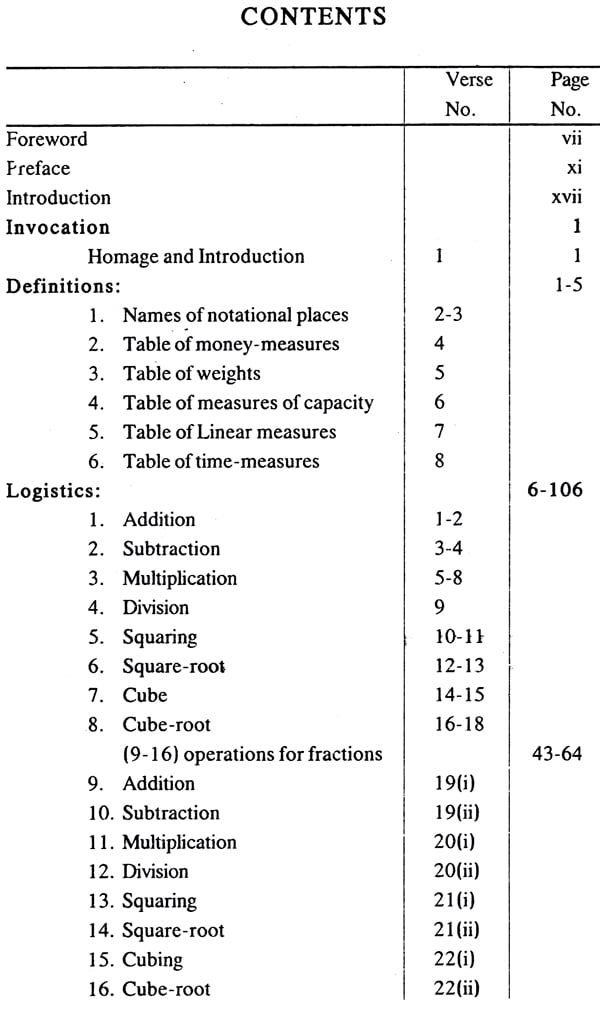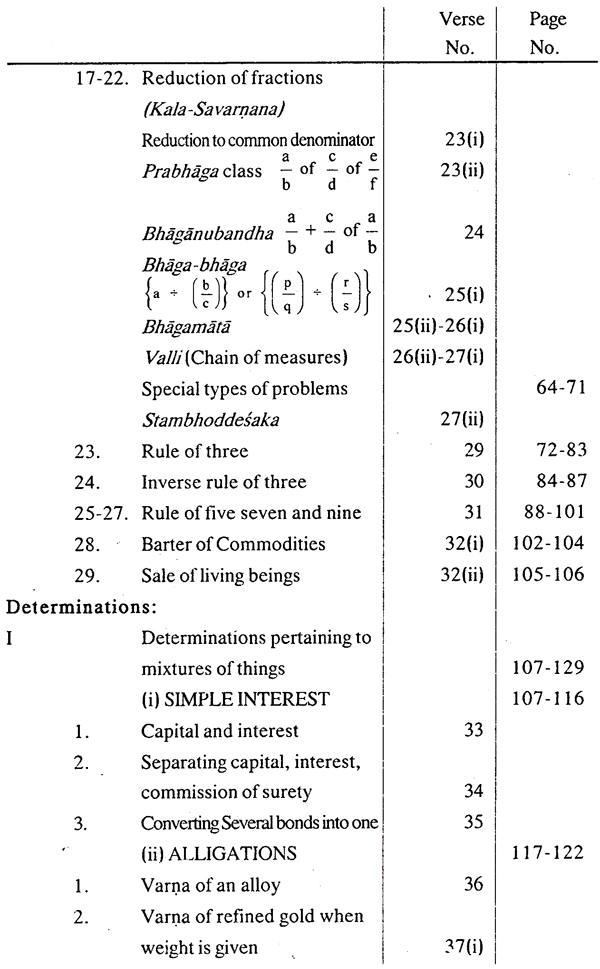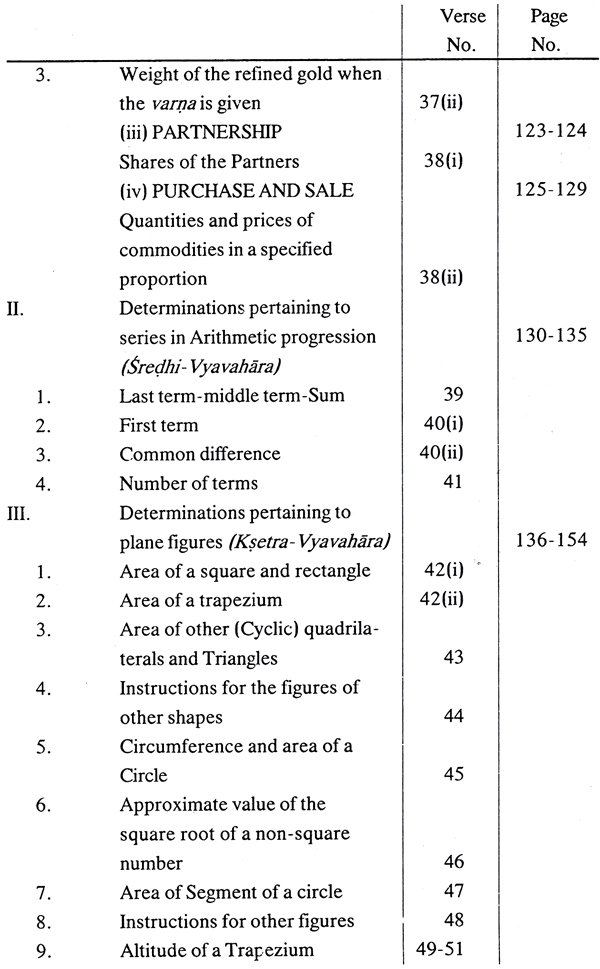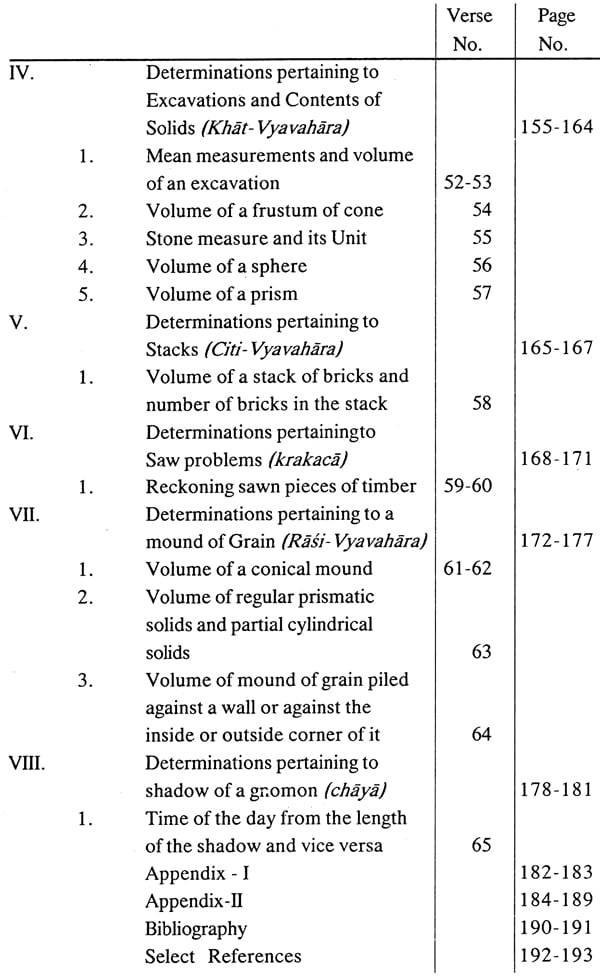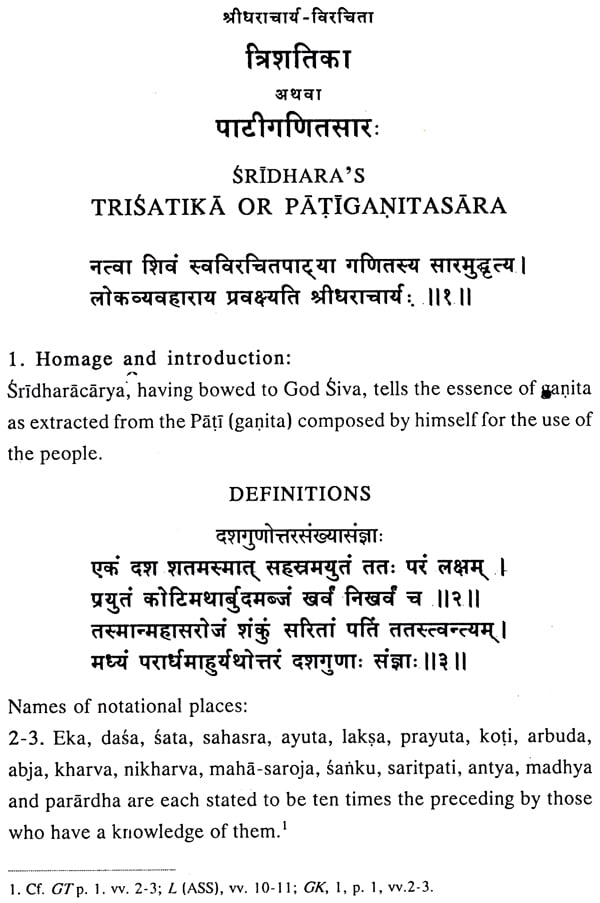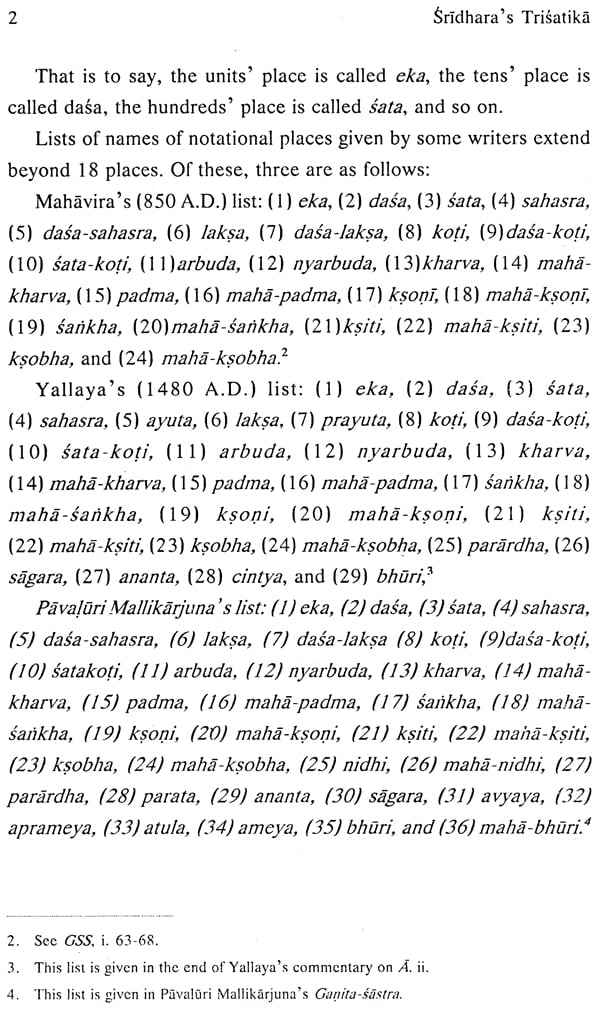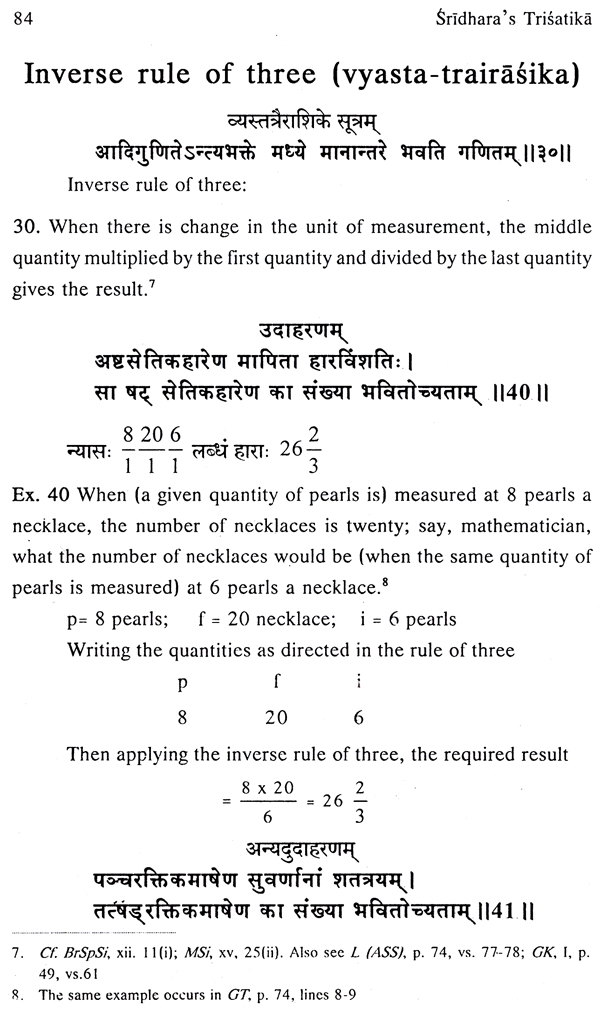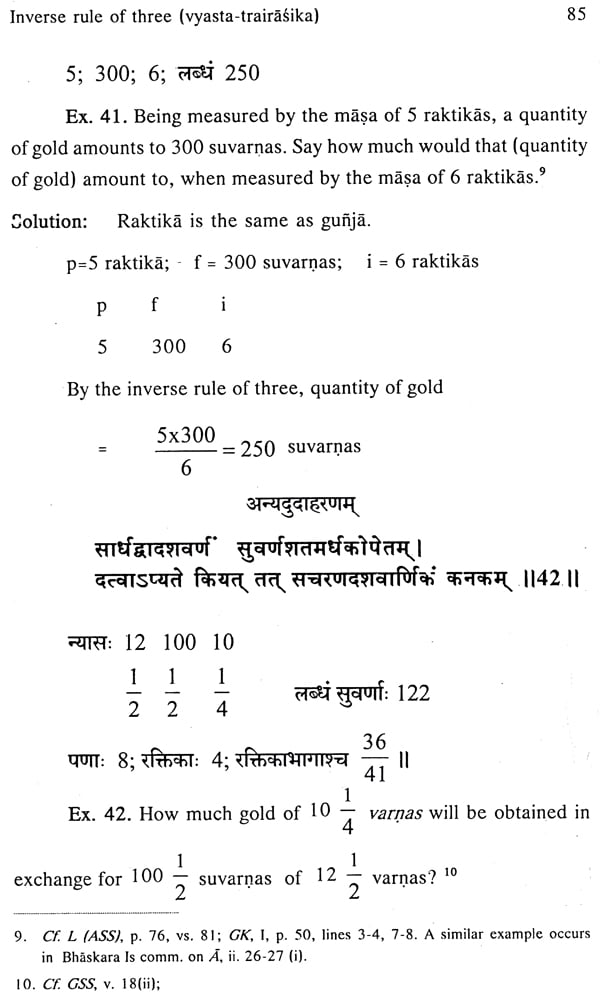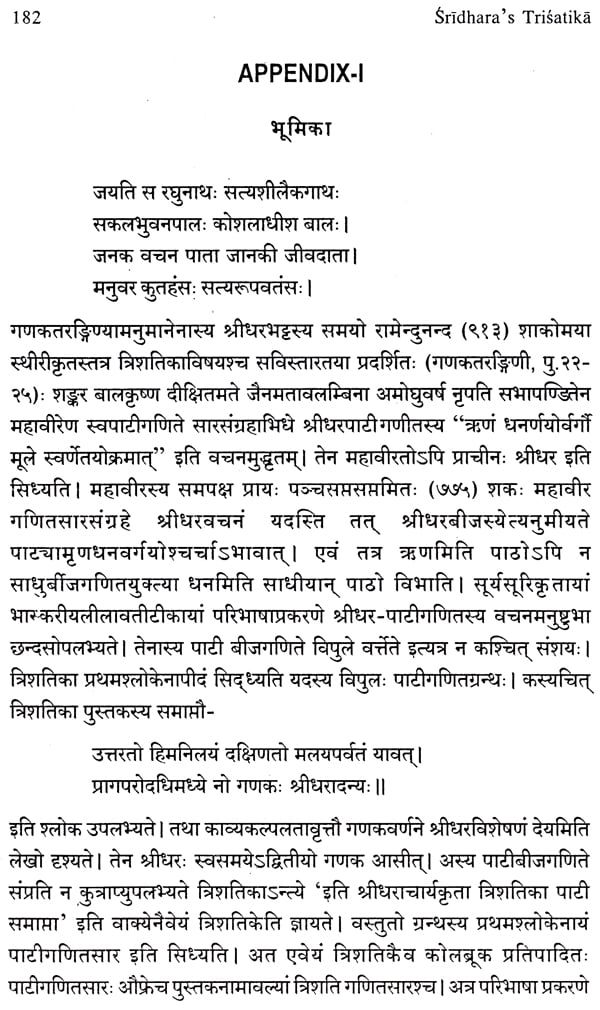
Trisatika or Patiganitasara
Book Specification
| Item Code: | NAS376 |
| Author: | Venugopal D. Heroor |
| Publisher: | old CHINMAYA INTERNATIONAL FOUNDATION |
| Language: | English |
| Edition: | 2015 |
| ISBN: | 9789380864204 |
| Pages: | 244 |
| Cover: | HARDCOVER |
| Other Details | 9.00 X 6.00 inch |
| Weight | 430 gm |
Book Description
Sri Venugopal D. Heroor, an Engineer by profession, is a keen and enthusiastic scholar of Ancient Indian Mathematics. He has brought out eleven books related to Indian Mathematics, which includes translation of the Sanskrit works; Sri dhara 's Tri6atika or Pali ganitasara, Bhaskaracarya's Jyotpatti, and Ganitadhyaya of Brahmagupta's Brahmasphutasiddhanta into both Kannada and English. He has translated Narayana Pandita's Ganita Kaumudi, Sridhara's Pat iganita, Bhakshaliyanuscript, Bhaskaracarya's Li lavat i and Citrabhanu's Ekavirp6ati Pragnottara into Kannada which are yet to be published. He has conducted classes for teachers and research scholars; presented papers at various universities, National and International Seminars.
The present work: l'iclhara's Trigatika or Fat iganitasara as its name implies and as the author himself says, is an abstract of Pat i ganita. It gives the important rules and examples of the Pat iganita with slight modifi-cations, alternations here and there, and provides a short course of arithmetic and mensuration to cater the needs of both students and business men. The work being written in simple clear the concise language, was greatly appreciated by the people in general for whom it was written.
The Present work contains the Sanskrit text of ridharacarya's Trigatikg' and an English translation with relevant notes and comments. The Sanskrit text adopted is as published in 1899 A.D., edited by Mahamahopadhyaya Sudhakara Dvivedi, Late professor of mathematics and astronomy in Sanskrit college, Benaras. Dvivedi gives no information about the manuscripts he used beyond stating that they were full of mistakes. Subsequently, an English translation of the rules (only) of The Tris'atika of i-iclharacarya' by N. Ramanujacharia was published in Bibliotheca Mathematica, (BM 3,13, 1912-1913, 203-217) with an introduction by G. R. Kaye. In the introduction, Kaye gives the following information about the most probable manuscript used by S. Dvivedi.
The manuscript is marked "No. 19 of the Jyotish Shastras" and the entry in the catalogue of Sanskrit Manuscripts in the Sanskrit College Library (Benaras 1911) is
"2291, No. 88- Sridhara-Pati'
Author- Srldharacarya
Complete Leaves 18 correct
Material : Paper
Script : Devanagari
At that time, Patiganita, Sfidhara's bigger work was not available to them either in manuscript or in print. Although a manuscript of this work existed in Raghunatha Temple Library at Jammu, it remained un-noticed by the early scholars till it was discovered by Late Dr. A.N. Singh in about, 1948A.D. Subsequently this work: The Patiganita of Sridharacarya (incomplete) with an ancient Sanskrit Commentary was edited with Introduction, English Translation and notes by Kripa Shankar Shukla and published by Department of Mathematics and Astronomy, Lucknow University in 1959. Patiganita-sara is also called Trigatika from the fact that it consists of 300 couplets. According to Sudhakara Dvivedi: 300 Couplets are made up of 8 relating to numeration, weights and measures; 65 are rules: 107 are examples and 120 are 'statements' of these examples.
Following Sudhakar Dvivedi, numbering of the verses containing, examples, and those containing definition and rules is carried out separately. While numbering it is noticed that, there is no verse number 28 containing the rules. After verse number 27, skipping 28, number 29 is given for the next verse. Also for the next half a verse, number 30 is given. Thus an error of verse is crept in. As it was the only printed edition of the work for a long period of about 100 years, scholars have referred the verse numbers from this edition in their research and study. So without making any corrections the verse numbers are retained as it is. To distinguish the two types of verses their number have been printed in different fonts.
The whole text of Trigatika is rendered into English. Technical terms which have their English equivalents have been translated into English; others have been kept as they are and have been explained. The portions of the English translation enclosed within brackets do not occur in the text and have been given in the translation to make it understandable, and are at places explanatory. For the verses of Tr/kit/kJ occurring in Patiganita, English translation of K. S. Shukla is reproduced here as it is. For the rest of the work, I have tried my best to keep the spirit of the original and have as far as possible not altered the sequence in the translation. 'Introduction' to Patigapita given in its printed edition by its editor K. S. Shukla is reproduced here with slight modifications incorporating the facts revealed in later research works.
The translation to each rule is preceded by a sentence or two giving in brief the contents of the rule and is followed, where necessary, by relevant notes and comments. Parallel rules and examples found in other available works on Hindu Mathematics have been indicated in the foot notes. Headings and sub-headings have been provided to facilitate consultation. Complete solution of the examples are given here for the benefit of the readers.
In compiling this work, I have been indebted to and relied on the expository source works by great savants like Sudhakar Dvivedi, B. Dutta, and A. N. Singh, K. S. Shukla, T. A. Saraswati Amma and R. C. Gupta. Works of K. S. Shukla have been the main source of inspiration for me for this work. Broadly speaking, mathematical matter found in the source works, and major highlight of historic matter found in the articles and research papers, have been collated and presented in this book. I express my sincere gratitude to all those stalwarts in the field.
I am grateful to Prof. P. V. Arunachalam for gracing this book with his valuable foreword.
I express my profound gratitude to authorities of CIFSS for taking up the task of publishing the work.
The author hopes that this book will be found to be quite useful and interesting.
Sridharacarya's (850-950 CE,?) times and place are matters of controversy. Some historians of mathematics opined that he hailed form Bengal and was a Shaivaite Hindu Brahmin. Others claim that he belonged to South India. Dr. K. S. Shukla considered that both the views are untenable. Some take him to earlier period, 750 CE and some others believe that he lived during the ninth and tenth centuries of the Christian era. Some classified sridhara as a Jaina mathematician and thus there are various views about the times of §ridhara. In different works, his life time has been placed from seventh century to eleventh. But Dr. R. C. Gupta, an authority on Ancient Indian Mathematics and its History, opines that it is safe to place §ridhara in the eighth century, be it beginning, middle or end'. Shri Heroor is in agreement with this view. Dr. R. C. Gupta would have formed this opinion from analyzing which other pieces of mathematics that he (§riclhara) was familiar with and also analyzing which later mathematicians were familiar with his works.
However, §ridhar5c5rya is famous for his outstanding contributions to mathematics. His mathematics is widely known as Pa ti-ganita, a name given to arithmetic and mensuration since long, in the lore of Indian mathematics, stretching back to the times of Baksali Manuscripts (200CE)
sridhara is known as the author of a few mathematical treatises, of them the following are well known (1)Payiganitaand (2) Triaatika, also known as Pa iganitasara.The Pat is also known as Navas'ati,a collection of 900 verses as against Triaatila, a collection of 300 vmes.It has yet two more abridged appellations namely 135il-sara or Gapita-sffra. Patiganita is also known as Brhatpaltimeaning bigger work of Pat igapita. Another work supposed to have been authored by Sridhara is Bijaganita. Unfortunately this work is not extant. Mathematical world came to know about this work, through the writings of Bhaskaracarya (1150), Makki Bhatta (1377) and Raghava Bhatta (1493). Yet another mathematical treatise Gapitapaticavims Presently, available texts of Sridhara are Kipkanita (with some parts missing) and Papkagitasara. The works of §ridhara influenced enormously generations of mathematicians of the medieval period. Aryabhat ta-II (950CE) of MalLYsiddlianta fame, Sri patimigra (1039CE) of Ganitatilaka fame, Bhaskaracarya (1150 CE) and Narayarja (1336 CE)- author of Ganitakauniudi, made extensive references to the results of Sridhara in their writings. The Jaina mathematicians, like Abhaya Deva Suri, Sirpha Tilaka Sufi and Amara SimhaYati were also inspired by reading Sridharacarya.
That is why Sridharacarya was hailed as
uttaratosurantlayarn daksipatomalayaparvatalp yavat/
pnigaparodadliimadhye no ganakah g'rldharadanyan /
The essence of the gloka is that there is no mathematician except §ridhara in the vast land bounded by Himalayas in the north, Malaya Mountains in the South and the oceans in East and West.
Some highlights of §rIdharacarya's contributions are:
• Computation of the volume of a sphere and
• Solution of quadratic equations.
In the Pa Itiganita which deals with arithmetic and mensuration, he discussed in details:-
• The elementary operations
• Extraction of square roots and cube roots
• Fractions
• Rules for operation with Zero and
• Summation formulas for arithmetic and geometric progressions.
The book of Sri Venugopal D. Heroor, Chartered Engineer, Gulbarga, is a scholarly presentation of Sridhardcdrya's Tris 1. PATIGANITA The Patiganita is the name given to that branch of Hindu Mathematics which deals with arithmetic and mensuration. It is believed that this subject attained an independent status sometime before the beginning of the Christian era, when arithmetic became a separate subject and geometry, which formerly belonged to a separate group of Sciences, viz., the Kalpasutra, came to be incorporated with it.' The earliest work exclusively dealing with this subject which has come down to us is the fragmentary manuscript known as the Balchshalf Manuscript= (text composed about 200 A.D.), which was discovered in 1881 A.D., at Bakhshali, a village near the city of Peshawar in the north-west of India, in course of excavation by a farmer. This work shows beyond all doubt that by the third century A.D., when its text was composed, the subject of Patiganita was already in state of maturity. 2. There are references to a number of other works on the subject which were in use in the fifth and sixth centuries in India. Bhaskara I (629 A.D.) refers to the works of Maskari Parana, Mudagala, Patana, and others, which were exclusively devoted to the subject of Patiganita. In the Aryabhatiya of Aryabhata I (b. 476 A.D.), written about the end of the fifth century A.D., there is a chapter which deals with mathematics and is called Ganita-pada, but this is too brief and does not give a clear idea of the state of mathematical knowledge in India in those times. According to Bhaskara I, the most competent scholiast of Aryabhata I, the subject matter discussed by Aryabhata I, in his Ganita-pada hardly deserves the name mathematics (Ganita). He has preferred to call it 'a bit of mathematics'. He writes: 'In the Ganita-pada the Acarya (Aryabhata) has dealt with the subject of mathematics (ganita) by indications only, whereas in the Kalakriya-pada and Gola-pada he has discussed reckoning with time (kAlakriya) and 'spherical astronomy' (gola) in detail. So by the word gahita (used by Aryabhata) one must understand 'a bit of mathematics'. Otherwise, the subject of mathematics is vast. There are eight vyavaharas (determinations), mi§raka (mixtures), greclhi (series), ksetra (plane figures), khAta (excavations), citi (piles of bricks), Krakacika (saw problems) and chaya (shadow). The mi4raka is that which involves the mixture of several things. The greclhi is that which has a beginning (i.e., first term) and an increase (i.e., common difference). The Ksetra tells us how to calculate the area of a figure having several angles. The Khata enable us to know the volumes of excavations. The citi tells us the measure of a pile in terms of bricks. The krakacika: The krAkaca (saw) is a tool which saws timber; that which relates to the sawing of timber, i.e., that which tells the measure of the timber sawn, is called Krakacika (vyavahara). The rAgi tells us the amount of a heap of grain, etc. The chaya tells us the time from the shadow of a gnomon, etc. Of the vyavahara-ganita (practical or commercial mathematics, i.e., Paggapita), which is thus of eight varieties, there are four bijas, viz., first, second, third, and fourth, ie., yavattavat (theory of the simple equation), vargavarga (theory of the quadratic equation), ghanaghana (` theory of the cubic equation'), and visama (` theory of the equations with several unknowns'). Rules and examples pertaining to each one of these have been compiled (in independent works) by Professors Maskari Purna, Mudgala and others. How can that be stated by the Acarya (Aryabhata) in a small work (like the Aryabhatiya)? So we have rightly said 'a bit of mathematics' 1.1: Patiganita works prior to fidhara: The works of Maskari Purarta and Mudgala referred to above have not survived the ravages of time, but from what Bhaskara I says about them they must have been exclusively devoted to Patiganita and algebra. Some of them might have existed before the time of Aryabhata I. Bhaskara I has quoted a numbers of arithmetical rules from those works, which tend to show that early works on arithmetic, though generally of the same nature as later works, now available to us, had the special peculiarity of including rules for verifying the results of calculation. Verification forms an intrinsic part of solutions given in the Bakhshall Manuscript. In the Aryabhattya, too, we find a rule meant for the verification of areas of plane figures. (See A, ii-9()). Bhaskara I has also sometimes verified his solutions. In later works we seldom come across any rules dealing with the verification of answers. 1.2: Lost works of Patiganita: The following works written during the eighth and ninth centuries and now not extant are: 1. The Patiganita of LaIla (8th century A.D.) Quotations from this work occur in Bhaskara II's commentary on the Siddhanta-Siromant and in the Ganita-Kaumudt of Narayaria (1356 A.D.) 2. The Siddhantatilaka of Lana (8th century A.D.) This work was similar to the Braluna-sphuta-siddhanta of Brahmagupta, and contained chapters on Arithmetic and Algebra. Quotations from this work occur in the commentaries of Ramakrstta Aradhya (1472 A.D.) and Yallaya (1480 A.D.) on the Silrya-siddhanta. 3. The Govindakrti of Govinda (9th century A.D.) **Contents and Sample Pages** 